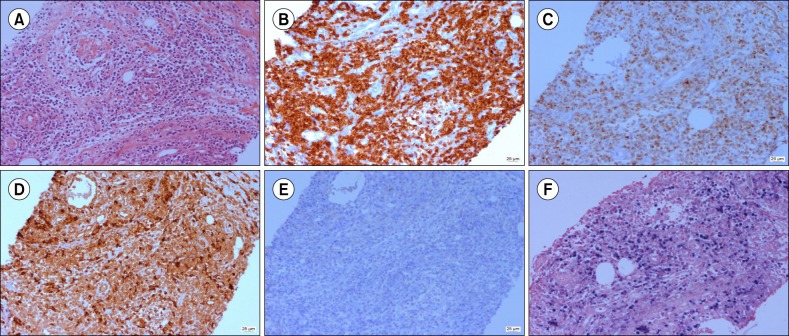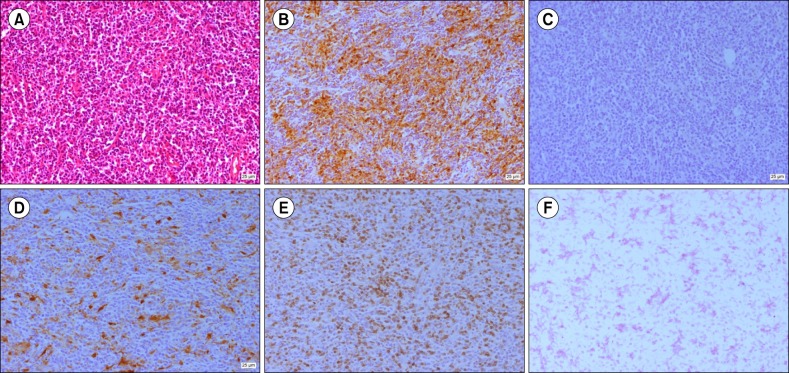Blood Res.
2017 Sep;52(3):224-227. 10.5045/br.2017.52.3.224.
An unusual case of metachronous NK/T cell lymphoma and interdigitating dendritic cell sarcoma
- Affiliations
-
- 1Division of Medical Oncology, Department of Internal Medicine, Yeouido St Mary's Hospital, College of Medicine, The Catholic University of Korea. yeony86@hanmail.net
- 2Department of Hospital Pathology, College of Medicine, The Catholic University of Korea, Seoul, Korea.
- 3Division of Hematology-Oncology, Department of Internal Medicine, Cheju Halla General Hospital, Jeju, Korea.
- KMID: 2390988
- DOI: http://doi.org/10.5045/br.2017.52.3.224
Abstract
- No abstract available.
Figure
Reference
-
1. Saygin C, Uzunaslan D, Ozguroglu M, Senocak M, Tuzuner N. Dendritic cell sarcoma: a pooled analysis including 462 cases with presentation of our case series. Crit Rev Oncol Hematol. 2013; 88:253–271. PMID: 23755890.
Article2. Vasef MA, Zaatari GS, Chan WC, Sun NC, Weiss LM, Brynes RK. Dendritic cell tumors associated with low-grade B-cell malignancies. Report of three cases. Am J Clin Pathol. 1995; 104:696–701. PMID: 8526215.3. Cossu A, Deiana A, Lissia A, et al. Synchronous interdigitating dendritic cell sarcoma and B-cell small lymphocytic lymphoma in a lymph node. Arch Pathol Lab Med. 2006; 130:544–547. PMID: 16594749.
Article4. Feldman AL, Arber DA, Pittaluga S, et al. Clonally related follicular lymphomas and histiocytic/dendritic cell sarcomas: evidence for transdifferentiation of the follicular lymphoma clone. Blood. 2008; 111:5433–5439. PMID: 18272816.
Article5. Shao H, Xi L, Raffeld M, et al. Clonally related histiocytic/dendritic cell sarcoma and chronic lymphocytic leukemia/small lymphocytic lymphoma: a study of seven cases. Mod Pathol. 2011; 24:1421–1432. PMID: 21666687.
Article6. Chen W, Lau SK, Fong D, et al. High frequency of clonal immunoglobulin receptor gene rearrangements in sporadic histiocytic/ dendritic cell sarcomas. Am J Surg Pathol. 2009; 33:863–873. PMID: 19145200.7. Miyata-Takata T, Takata K, Yamanouchi S, et al. Detection of T-cell receptor γ gene rearrangement in paraffin-embedded T or natural killer/T-cell lymphoma samples using the BIOMED-2 protocol. Leuk Lymphoma. 2014; 55:2161–2164. PMID: 24308432.
Article8. O'Malley DP, Agrawal R, Grimm KE, et al. Evidence of BRAF V600E in indeterminate cell tumor and interdigitating dendritic cell sarcoma. Ann Diagn Pathol. 2015; 19:113–116. PMID: 25787243.9. Ma C, Zhang X, Zhao Y, Wang G, Zhang M. Detection and significance of BRAF gene in mature T/NK cell lymphoma. Zhonghua Zhong Liu Za Zhi. 2015; 37:816–822. PMID: 26887510.
- Full Text Links
- Actions
-
Cited
- CITED
-
- Close
- Share
- Similar articles
-
- A Case of Cutaneous Interdigitating Dendritic Cell Sarcoma on the Chest
- Interdigitating dendritic cell sarcoma occured alone in axilla
- Interdigitating Reticulum Cell Sarcoma of Lymph Node
- A Case of Extranodall NK/T-cell Lymphoma, Nasal type
- Extranodal Interdigitating Dendritic Cell Sarcoma Presenting in the Pleura: A Case Report




